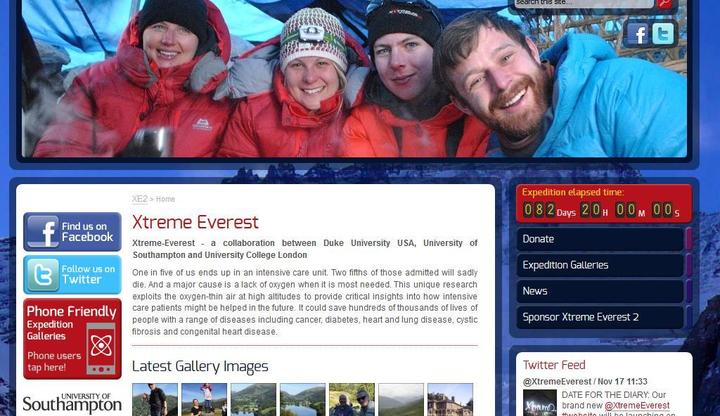Archive website
Archived Xtreme Everest 2 Website
The Xtreme Everest researchers returned to Everest Base Camp in 2013. Continuing their investigations of human adaptation to hypoxia at high altitude, the key areas of interest for 2013 expedition were:
- Sherpas
Sherpas are renowned for being kings of the mountain yet little is known about the differences in their physiology that generate such clear advantages over lowland individuals. Whilst they have undoubtedly inherited genes to aid this from their forefathers, the precise mechanism by which they adapt remains unclear. If we could unravel the secret of Sherpas, we may be able to replicate their superior physiology in critically ill patients.
- Children
In 2007 the team studied a small group of children as they ascended to high altitude, taking measurements that had never previously been recorded. The success of this small pilot study led to the creation of a comprehensive study of physiology in children in 2013. A larger group of children followed the path taken by Hilary and Tenzing to a laboratory specially designed for them. Here they underwent rigorous testing to compare their adaptive responses to those of the adults.
- Twins
Identical twins share identical genes, yet they exhibit subtle differences. Some of these differences arise from the way in which genes are translated and this emerging field of human biology is called epigenetics. Understanding how our DNA code is modulated throughout life may explain the interactions of nature and nurture. Epigenetics can alter the way we respond to certain circumstances and adaptation to hypoxia may be influenced in this way. We studied identical twins to develop a better understanding of the influence of epigenetics on acclimatisation that could pave the way for artificially influencing it in critically ill patients to promote adaptation and reduce harm.
- Drug trials
We were also testing a compound previously studied on our expedition to the Alps in 2010, which aimed to make our lowland travellers 'Sherpa-like.' Initial results from the Alps show that the compound can mimic the blood chemistry of Sherpas and the team were aiming to see if it makes their subjects as fit as Sherpas at high altitude.
The expedition took place from March to May 2013.





